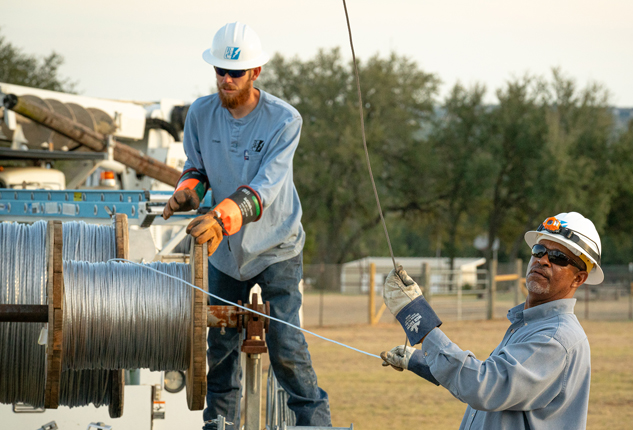Vegetation Maintenance
Vegetation maintenance and tree trimming
We’re dedicated to preserving the life and beauty of the Texas Hill Country. We trim trees and maintain vegetation around our equipment and rights of way so that we can deliver the safe, reliable power you depend on. We follow American National Standards Institute guidelines that support tree health, minimize pruning stress, and allow for directional pruning methods to gain line clearance. Learn more about what we do and how you can stay safe while working on your property.
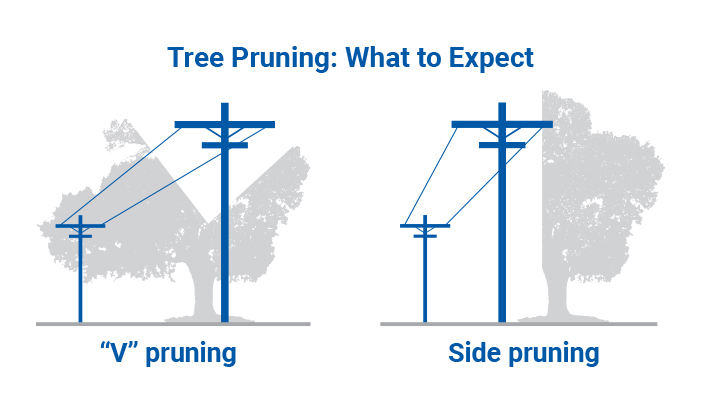
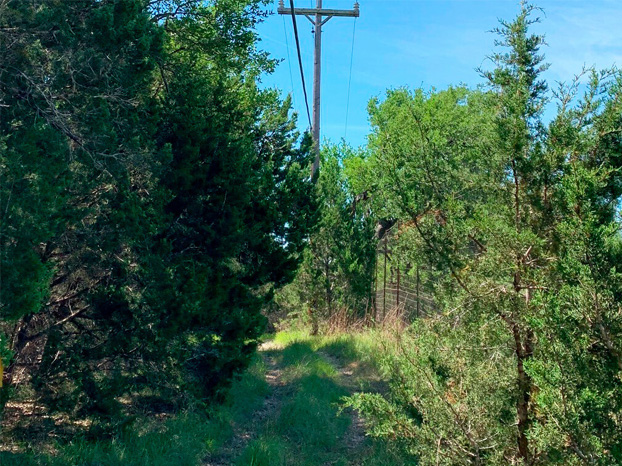
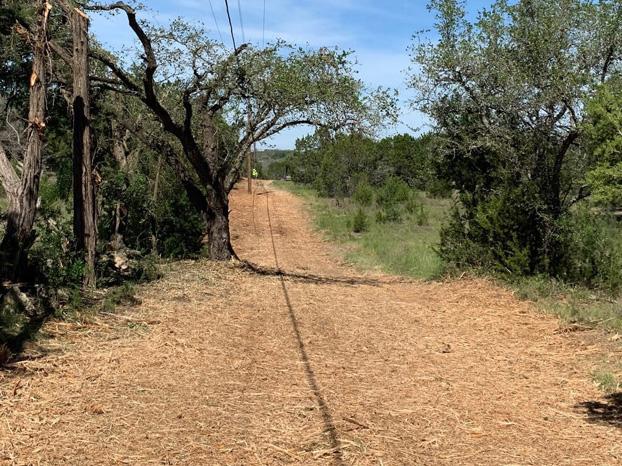
Tree trimming
To ensure reliable electric service, our crews may trim trees away from power lines. Utilizing LiDAR technology, we prioritize maintenance where vegetation poses a risk to electric equipment.
Trimming trees near electrical equipment is dangerous — never do it yourself. Electricity can jump from the power lines to your body, your tools, or nearby branches, causing injury or even death.
If you see trees growing near our lines and facilities, call us at 888-554-4732, Monday through Friday, between 8 a.m. and 5 p.m. A service order will be issued, and a PEC utility forester will contact you and send a crew to safely clear the vegetation.
Right of way
We’re committed to providing reliable electric service to you, your neighbors, and your community. To do that, we must maintain properly cleared and accessible rights of way around our lines and equipment. Rights of way for distribution lines that carry power to homes and businesses are typically a minimum of 10 feet on each side of the lines, while rights of way to either side of our transmission lines range from 30 to 50 feet. We need this clearance to safely maneuver our large utility vehicles as we and our contractors work to install, repair, and maintain electrical equipment.
In areas with underground electric service, do not plant shrubs or other vegetation around pad-mounted transformers or otherwise hide or block access. Obstructions near this equipment will make maintenance work hazardous or difficult for crews and may increase outage restoration times. Ten feet of clearance is needed in front of equipment so crews can safely open it, and 5 feet on each side allows easy access. Some large pad-mounted electric equipment requires 10 feet of clearance in the front and back.
If you receive service from us, you have granted easement rights to the cooperative. Do not build or place structures, locked gates, landscaping, or other obstructions in the right of way. These can create safety hazards for our crews and slow or prevent maintenance, including power restoration, for you and those around you. If you have questions about the location of an easement on your property, please call us toll-free at 888-554-4732, Monday through Friday between 8 a.m. and 5 p.m.
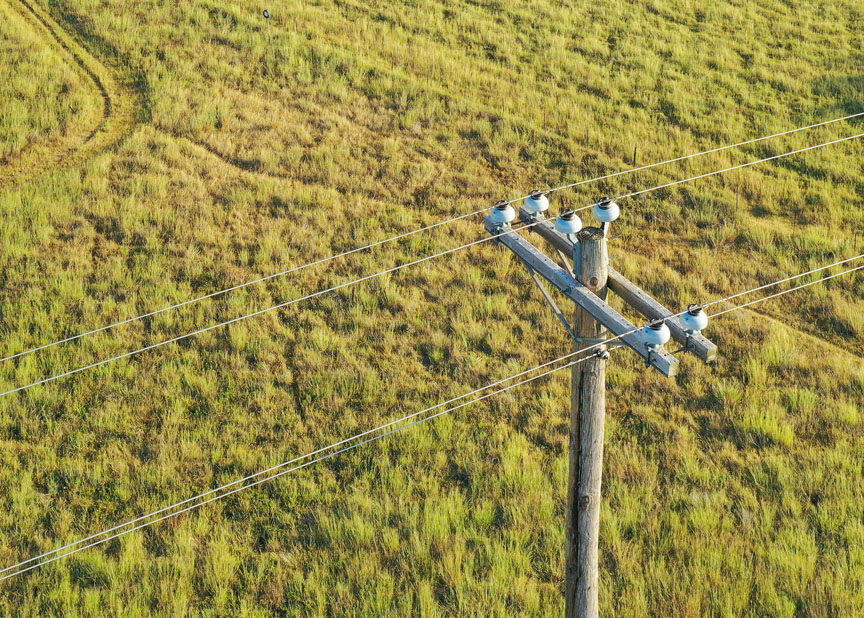
Frequently Asked Questions
At PEC, we know you want your trees and landscaping to thrive — and so do we! To learn more about our vegetation maintenance practices, please read our frequently asked questions (FAQs) below. If you have additional questions or concerns not addressed in this list, please contact us at 888-554-4732.
Our trained vegetation specialists are members of the International Society of Arboriculture (ISA) and ISA Texas Chapter. Continuing education and certification enhances our team’s ability to educate our members and provide excellent service.
Our vegetation maintenance team stays up to date with best practices in the industry to provide the highest level of service. Continued education, trainings, and certifications keep us abreast of the latest professional standards and developments in the field.
Our team holds International Society of Arboriculture (ISA) certifications in the following categories: Certified Arborist, Certified Utility Specialist, Texas Oak Wilt Certified, Tree Risk Assessment Qualification, and Wildfire Risk Assessment Qualification. The team is also certified by the Texas Department of Agriculture in Non-Commercial Pesticide Application.
Please promptly report any dangerous issue with power lines to PEC by calling us at 888-554-4732. If you see a life-threatening situation, call 911 immediately.
All PEC contractors carry required identification and will only trim vegetation within the utility easement or where it presents a safety or reliability threat.
Transmission lines carry electricity from power plants to substations and between substations. These high-voltage lines are typically located on tall steel or concrete poles.
Distribution lines carry electricity from substations to the end user. These are typically shorter, wooden poles. They may have from one to three, or more, uninsulated energized lines.
Oak wilt is a fungal disease that can cause leaf discoloration and loss, wilting, or death in oak trees. The disease can be spread by improper pruning methods, insects, and contact between tree roots. Our utility foresters and staff protect against oak wilt by observing ISA standards and practicing proper pruning methods, including:
- Trimming at the correct angle.
- Sanitizing trimming instruments with disinfectant before beginning work and when moving from one tree to the next.
- Sealing wounds on trees with limb sealant.
- Exercising awareness of how and when oak wilt spreads.
Tree trimming FAQ
Trees can disrupt power by growing into the electrical equipment or falling across power lines, causing outages.
To provide reliable service, we prune or remove trees along the power lines. These practices are approved by internationally recognized tree care associations and are referred to as Integrated Vegetation Management (IVM).
PEC will provide notification prior to vegetation maintenance work. Notification may be made via door hanger, telephone call, letter, in-person contact, or a combination of these methods. A point of contact will be provided should you have questions or concerns about the upcoming vegetation work. If our attempts to notify you are unsuccessful, work will proceed without further direct notification.
Industry standards for right of way management have changed in recent years as a result of several widespread outages, including one in the Northeast affecting 50 million people in eight states and portions of Canada. Utilities operating high-voltage transmission lines are required to establish and follow a vegetation management program that eliminates all threats to safety and ensures reliability of high-voltage transmission lines.
The objective of the Integrated Vegetation Management (IVM) program is to evaluate vegetation and determine the best methods for maintenance and tree removal to ensure reliable service. Our program’s objective is to minimize tree-related power outages in a manner that is consistent with good arboricultural practices.
PEC prioritizes pruning of specific sections that are closest to electric lines. Some sections of the line on a member’s property may be scheduled based on vegetation-to-line proximity.
Trimming trees near electrical equipment is dangerous — it’s never a do-it-yourself job. Electricity can jump from the lines to your body, your tools, or nearby branches, causing injury or even death.
If you see trees growing near our lines or facilities, call us at 888-554-4732, Monday through Friday, between 8 a.m. and 5 p.m. A service order will be issued, and a PEC forester will contact you and send a crew to safely clear the vegetation, free of charge.
Trimming trees near electrical equipment is dangerous — it’s never a do-it-yourself job. Electricity can jump from the lines to your body, your tools, or nearby branches, causing injury or even death.
If you see trees growing near our lines or facilities, request tree-care service online or call us at 888-554-4732, Monday through Friday, between 8 a.m. and 5 p.m. A service order will be issued, and a PEC forester will contact you and send a crew to safely clear the vegetation.
Members can help PEC minimize tree-related outages and maintain the beauty of their landscapes by thoughtfully planting new trees. Plant trees at least as far away from the lines as their natural canopy spread. Spreading trees, such as elms, oaks, and maples, are common outage-causing culprits and should be planted at least 40-50 feet away from power lines.
Before planting trees on your property, consider the location of utility lines. Call 811 before you dig — it’s the law and it could save your life.
Fast-growing trees, such as hackberry, or invasive species, such as chinaberry or Chinese tallow berry trees, will be removed when necessary. Trees that are dead, dying, or diseased will be removed for the safety of the public and the reliability of our system.
If overhead electric lines service your home, never get too close to the lines and don’t take tools or other objects near the lines. If you have underground electric service, never dig until you know where the lines are buried.
Only during emergency or access situations would a lineworker perform tree trimming. We hire reputable and qualified contractors to do maintenance pruning.
That depends on a lot of different factors: the proximity of your tree to our lines, the growth habit of the tree, the size of the limbs that need to be removed, the availability of suitable lateral limbs to prune to, and other previous work that has been done to the tree.
PEC does not round over or shape trees. This practice generally contributes to poor tree health. We employ directional pruning methods endorsed by tree care professionals and American National Standards Institute A300 standards. The basis for proper pruning is that each limb removed from a tree is removed either where it joins another limb or at the trunk. These procedures are different than “rounding” trees over, in which limbs are cut at arbitrary points, normally leaving unhealthy “stub” cuts.
ANSI A300 standards unify and take authoritative precedence over all previously existing tree care industry standards and guidelines.
Your trees may not be touching the wires, but in high winds or during peak load times, they could sway into the lines. The electric line is high-voltage wire, which can cause burning and eventually degrade the quality of the wire. Also, all the trees on PEC’s system should be on the same approximate maintenance schedule. This improves reliability to our membership as a whole and reduces the number of trips we make to maintain that reliability. This also reduces the time it takes to restore power. Pruning limbs before they cause a problem is ideal. By doing so, we can direct the growth away from the lines.
Our standards are based on several factors: the minimum safe working distance for a tree worker, how much trees sway in high winds, the amount of ice on a tree before it touches a power line, the ability of limbs to break and fall on lines, and the varying growth and regrowth rates of different species of trees.
Our goal is to deliver safe and reliable electric service to all our members, across our entire service territory.
Herbicide FAQ
Yes, in limited locations and under strict regulatory guidelines. All products used are federally registered and labeled for specific uses by the U.S. Environmental Protection Agency (EPA) and are applied by licensed applicators according to product label directions.
The targeted use of herbicides is part of an overall strategy — one that also includes hand-cutting and mowing/mulching — to help control vegetation in PEC rights of way in order to improve reliability and more quickly and safely restore outages when they occur. Herbicides are a cost-effective method to control certain types of vegetation in selected areas. The overarching goal is to promote low, slow-growing species that are compatible with power lines and discourage tall, fast-growing species that could interfere.
PEC applies herbicides year round in optimal weather conditions.
Licensed applicators walk the rights of way with hand-operated backpack sprayers and apply the product to the leaves of small trees and brush. Herbicides are applied only by manual methods that target individual plants or compact clusters of plants. Aerial or wide-area spraying is not performed. Herbicide applications specifically target fast-growing tree species that could interfere with electric facilities. Grass, flowers, vegetables, and low-growing shrubs will not interfere with the power lines and are not targeted during herbicide applications.
Herbicide applications do not take place within 100 feet of known private water supplies or 200 feet of public water supplies.
Workers applying herbicide will go door to door to speak with or leave information for residents in advance of the planned applications. Members may also be notified by email or mail.
When an herbicide application is planned in your area and the applicators go door to door, they will leave a door notice with their contact information on it if you are not home. If you have a water supply within 100 feet of the right of way or have any other questions or concerns, be sure to contact them within five business days. If five days have passed and they have not heard from you, the application will take place as planned, without any further notice.
After receiving all available information regarding herbicide applications, you may request that herbicides not be used on your property by calling 888-554-4732. Once we receive the notification, we will honor the request.
If you have previously let PEC know that you do not want herbicides applied to a right of way on your property, we will not apply herbicides in that area. We suggest landowners contact us to update information/requests every five years.
We use a range of different herbicides depending on the year, location, and other environmental factors. If you have questions about specific herbicides, please contact our Vegetation Department at [email protected].
The U.S. Environmental Protection Agency (EPA) approves products for use only after determining they will not adversely affect people, animals, or the environment when applied correctly. All products used are federally registered and labeled for specific uses by the EPA and are applied by licensed applicators according to product label directions.
Right of Way FAQ
Transmission lines are only insulated by air. They require regular maintenance of surrounding vegetation to sustain minimum clearances of obstructions. PEC’s vegetation management program ensures the transmission system meets company, industry, and federal standards to ensure the safe and reliable delivery of electricity to members while also providing access to maintain facilities.
Yes. Our policies have evolved with industry standards. Previously, it was not uncommon for PEC to allow certain trees and vegetation to remain. PEC also allowed trimming and pruning rather than removal to provide adequate clearances between power lines and trees. This approach in the utility industry has repeatedly proven ineffective in preventing outages, arcing, and fire and shock hazards.
Industry standards for right of way management have changed in recent years as a result of several widespread outages, including one in the Northeast affecting 50 million people in eight states and portions of Canada. Utilities operating high-voltage transmission lines are required to establish and follow a vegetation management program that eliminates all threats to safety and ensures reliability of high-voltage transmission lines.
Yes. We negotiate a right of way easement the length of all transmission lines. This allows PEC to trim or remove all trees and brush on or near the right of way as needed to safely and efficiently survey, construct, reconstruct, relocate, inspect, repair, replace, maintain, operate, and remove transmission lines. The easement also allows us to trim or remove trees that could potentially fall within 15 feet of the nearest power line.
No, our easement allows access to private property to construct, reconstruct, operate, maintain, and patrol transmission lines.
A PEC representative will make every attempt to notify you of work that needs to be completed. However, it may be necessary to perform emergency trimming or removal without prior notification to eliminate potential tree/power line hazards.
Right of way widths range from 50 to 200 feet depending on the size of the power line. The higher the voltage of the power line, the more clearance required. Electricity traveling through these lines will look for the most direct path to the ground by jumping or arcing to nearby objects, including a tall-growing tree. To avoid this, we maintain a safe distance between power lines and tree limbs.
A clear zone is maintained on all sides and below power lines to keep a safe distance between anything that can conduct electricity. We must also make allowances for line sag, wind, and weather conditions. A heavy electrical load on a very hot day will heat up and stretch power lines, causing them to sag. Since the amount of sag varies, a safe clearance in winter may not provide the same safety on a summer day. Additional hazards include heavy winds that can blow branches into power lines, and extra weight from snow and ice that bend or break branches, causing a potential flashover.
Yes. PEC uses qualified contractors to apply herbicides that are approved and labeled by the EPA. Herbicides allow for selective removal of undesirable vegetation with minimal impact to the surrounding environment. They also extend the time interval between more invasive practices, such as mowing. Maintaining rights of way with the use of herbicides frequently results in more ecologically diverse, healthy, and aesthetically pleasing corridors than those maintained only by mechanical means.
Yes, PEC will trim or remove a tree if it is structurally weakened, considered a fast-growing or soft-wooded species, or poses a danger to the integrity of the transmission line. A danger tree is any tree located inside or outside the right of way that would fall within 15 feet of a power line or within 5 feet of a transmission structure. Most easements grant PEC the right to trim or remove these trees for the protection of the transmission line, and for the safety and reliability of the transmission system.
Most trees should not be planted within the right of way. PEC will approve selected low-growing vegetation at carefully chosen locations, provided it does not exceed other requirements for reliable operation or impede access to the transmission line. Contact PEC’s Vegetation Management Department for a consultation. Remember, vegetation located within or along the immediate edge of the right of way is planted at your own risk.
Yes. Deer stands should be located in the outer edge of the right of way and must not exceed 15 feet in height. Do not attach deer stands to power poles or under power lines.

Contact us
Do you have a vegetation issue or question about a contractor? Contact us at 888-554-4732
Monday through Friday, 8 a.m. to 5 p.m.

Planting guidelines for your home
Stay safe and help improve reliability by following these important planting guidelines.
